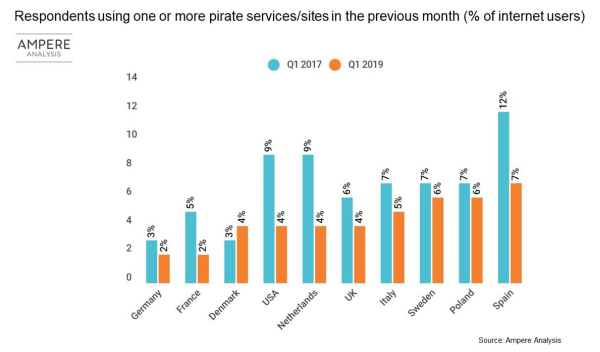Video Piracy Rates Drop Sharply, But For How Long?

In many countries, the idea of ‘on-demand’ video was popularized by piracy. This was often the only way for people to watch what they want, whenever they liked.
Over the past decade, the legal options have gradually improved. More content is available and people have plenty of options to stream the latest hit-series or Hollywood blockbusters.
According to new consumer research by Ampere Analysis, this is one of the reasons why video piracy rates are dropping in several countries, including the United States, France, Spain, and Germany.
The bar chart below shows the percentage of people who used one or more video piracy services in the previous month. Without exception, video piracy rates declined during the three year period from 2016 to 2019 in all countries that were polled.
The drop was most pronounced in France, the United States, and the Netherlands where the number of people using piracy services in the past month was decreased by more than half. Spain also saw a sharp decline, from 12% to 7%.

Richard Broughton, Director at Ampere Analysis, links the changes to the increased availability of on-demand services, such as Netflix, which directly compete with piracy.
“On average, in markets where either catch-up or SVoD online video viewing has risen the most, piracy has experienced the biggest drop. With the growth in all-you-can-eat legal services, users no longer need to turn to illegitimate sources to get their viewing fix,” Broughton notes.
This is backed up by data. In Spain, for example, the use of legal SVoD and catch-up services grew by 47% while the number of people that use piracy services and sites dropped by 45%.
While this is positive news for entertainment companies, there is also reason for concern. Increasingly, the legal video streaming landscape is becoming more fragmented or siloed. This means that people have to pay for more services to see what they want.
These new restrictions could push people in the direction of pirate sites again.
“The on-demand market is moving into a period of ‘siloization’ where producer and distributor brands go direct to the consumer, at the same time restricting the amount of content they license to third party services,” Broughton says.
“If the mainstream OTT players have less of the content users want to watch, when they want to watch it, there’s a genuine risk that usage of these SVoD and catch-up services could begin to slump, something the pirate operators will be quick to capitalize on.”
This isn’t just a hypothetical threat either. Most households have a limited budget for online entertainment, so consumers eventually have to choose which services they want. This is a problem that keeps getting worse, especially now that more services have ‘exclusive’ titles.
Recent research by piracy research firm MUSO revealed that 80.4% of UK consumers already feel that they’re already paying too much for content streaming. More than half of these said they were likely or very likely to use unlicensed platforms to search for content that’s not available to them.
These people are all willing to pay. However, in order to get everything they want, they are happy to complement their legal viewing with the occasional pirate download or stream.
Source: TF, for the latest info on copyright, file-sharing, torrent sites and more. We also have VPN reviews, discounts, offers and coupons.




Leave a Reply
Want to join the discussion?Feel free to contribute!